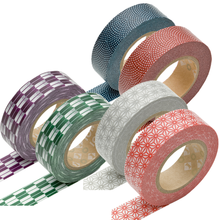
Back واشي (ورق) Arabic Vaşi Azerbaijani Washi Catalan Japanpapir Danish Japanpapier German Washi Esperanto Washi Spanish واشی Persian Japaninpaperi Finnish Washi French
This article has multiple issues. Please help improve it or discuss these issues on the talk page. (Learn how and when to remove these template messages)
|


Washi (和紙) is traditional Japanese paper processed by hand using fibers from the inner bark of the gampi tree, the mitsumata shrub (Edgeworthia chrysantha), or the paper mulberry (kōzo) bush.[1]
Washi is generally tougher than ordinary paper made from wood pulp, and is used in many traditional arts. Origami, shodō, and ukiyo-e were all produced using washi. Washi was also used to make various everyday goods like clothes, household goods, and toys, as well as vestments and ritual objects for Shinto priests and statues of Buddha. It was even used to make wreaths that were given to winners in the 1998 Winter Paralympics. Washi is also used to repair historically valuable cultural properties, paintings, and books at museums and libraries around the world, such as the Louvre and the Vatican Museums, because of its thinness, pliability, durability over 1000 years because of its low impurities, and high workability to remove it cleanly with moisture.[2][3][4]
As a Japanese craft, it is registered as a UNESCO intangible cultural heritage.[5]
- ^ Hughes, Sukey (1978). Washi: the world of Japanese paper. Tokyo: Kodansha International. ISBN 0-87011-318-6.
- ^ "Paper conservation by using Japanese paper, washi". International Federation of Library Associations and Institutions. Archived from the original on 9 February 2022.
- ^ "The elegant and refined world of washi". Toki. 30 August 2015. Archived from the original on 6 April 2017.
- ^ "Washi paper in Mino". ANA. Archived from the original on 5 April 2022.
- ^ "Government, paper makers welcome addition of 'washi' to UNESCO list". 27 November 2014. Archived from the original on 13 January 2017. Retrieved 27 November 2014.
© MMXXIII Rich X Search. We shall prevail. All rights reserved. Rich X Search